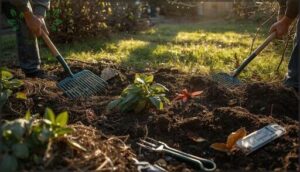This site is supported by our readers. We may earn a commission, at no cost to you, if you purchase through links.
 Most spring mornings, your garden wears the aftermath of winter like a badge—patchy grass, stubborn debris, and shrubs that seem to sulk beneath tired branches. It’s not neglect, it’s nature’s way after a long cold stretch.
Most spring mornings, your garden wears the aftermath of winter like a badge—patchy grass, stubborn debris, and shrubs that seem to sulk beneath tired branches. It’s not neglect, it’s nature’s way after a long cold stretch.
Still, as you kneel to test the soil or run your fingers along a cracked flowerpot, the potential in every corner feels undeniable. With a handful of smart spring garden renewal tips, you can coax hidden life back to the surface, turning that wake of winter into a canvas for fresh growth.
The changes you make now set the scene for everything ahead.
Table Of Contents
- Key Takeaways
- Assessing Your Spring Garden’s Needs
- Essential Spring Garden Cleanup Tasks
- Improving Soil Health and Fertility
- Smart Planting and Pruning Strategies
- Sustainable Maintenance and Pest Prevention
- Frequently Asked Questions (FAQs)
- How do I test my garden soil at home?
- What tools work best for aerating raised beds?
- Should I replace or amend old garden soil?
- How can I improve clay-heavy garden soil?
- Whats the ideal raised bed soil depth?
- How do I attract beneficial insects without chemicals?
- What flowers bloom earliest for spring color?
- Which garden trends are popular for small spaces?
- How can I add edible plants to my landscape?
- What are tips for successful vertical gardening?
- Conclusion
Key Takeaways
- Giving your garden a thorough spring assessment—checking plants, soil, and structures—sets the stage for healthy growth all season.
- Prompt cleanup like removing debris, pruning, and sanitizing tools prevents disease and preps your space for new planting.
- Improving soil with compost, aeration, and mulch builds strong roots and boosts resilience against drought and pests.
- Smart spring habits like organic pest management, efficient watering, and careful crop choices support a vibrant, sustainable garden.
Assessing Your Spring Garden’s Needs
Every spring, your garden asks for a little extra attention to bounce back from winter. Before you start planting or pruning, it’s helpful to look closely at what your space really needs now.
Here are a few key areas worth checking as you get started.
Surveying Trees, Shrubs, and Lawns
As spring nudges your garden awake, a thoughtful yard assessment sets the stage for success. Start with these steps:
- Scan tree canopies for health indicators.
- Check shrubs for bloom readiness and prune for structure.
- Conduct lawn soil testing to guide care.
- Spring is an ideal time to pruning select shrubs to think about pruning for best growth.
- Use integrated garden surveys for data-driven pruning and coordinated shrub care, ensuring your whole outdoor space thrives.
Identifying Winter Damage and Disease
Once you’ve finished sizing up trees and shrubs, keep an eye out for signs of frost damage on buds and stems, or winter burn on evergreens—yellowing needles are a giveaway. Evergreen plants, especially those in exposed locations, are at increased risk of experiencing winter burn. Snow mold may cause patchy, matted turf. Inspect woody plants for cankers, and clear winter debris to discourage garden pests and diseases that thrive in shifting spring temperatures.
| Issue | What to Look For |
|---|---|
| Frost damage | Blackened buds, wilted tips |
| Snow mold | Matted, discolored grass |
| Winter burn | Yellow or brown needles |
| Disease prevalence | Spots, lesions on leaves |
| Pests/disease | Chewed bark, dead patches |
Evaluating Soil Condition and Drainage
After spotting winter’s mark on your plants, don’t ignore what’s happening underground. Your soil’s health sets the tone for everything ahead. Take time to:
- Test soil pH and nutrient levels
- Check drainage rate with a quick percolation test
- Note soil texture by feel
- Watch for compaction impacts from foot traffic
- Adjust for balanced soil fertility
Inspecting Hardscaping and Garden Structures
Give your outdoor space a close look—those garden structures and hardscaping features tell a story after winter. Look for damage identification, from cracks in patio stones to leaning fences, since these issues affect both longevity and financial impact.
Prompt hardscaping upkeep aids structural longevity, while selecting modern, resilient material trends and minding ongoing maintenance requirements help prevent bigger repairs down the road.
Essential Spring Garden Cleanup Tasks
Spring brings a fresh start, but your garden needs a proper reset before the real growth begins. Tackling a few key cleanup jobs now can make all the difference for the season ahead.
Here’s what to focus on as you roll up your sleeves.
Removing Debris and Dead Plant Material
Ever wonder how leftover winter debris can sabotage your hard-earned garden? Prompt spring garden cleanup—removing dead plant material—sets the stage for Disease Prevention and soil enrichment. Composting methods transform what you clear into garden gold. Plus, tidying up strengthens Pest Control and reduces environmental impact.
Try these tactics:
- Rake away fallen leaves
- Cut back dead stems
- Clear out spent blooms
- Compost plant debris
Cleaning and Organizing Garden Tools
When spring rolls around, cleaning and organizing garden tools isn’t just busy work—it’s the backbone of smart garden preparation. Use a wire brush or bleach solution for tool sanitation methods, sharpen blades for smoother cuts, and opt for ergonomic tool storage to prevent rust. Keeping tools accessible and maintained transforms your spring garden cleanup into an easy, satisfying routine.
Refreshing Bird Feeders and Bird Baths
For garden wildlife, your spring cleaning routine hinges on more than surface shine—it’s about Feeder Hygiene and Water Quality. Disease Prevention starts here:
- Scrub bird feeders weekly to block fungal and bacterial outbreaks.
- Use a vinegar solution in bird baths and swap water daily.
- Opt for ethical feeding mixes, adjusting for seasonal bird needs.
Tiny efforts safeguard your garden’s visitors.
Clearing and Preparing Garden Beds
Ready to turn the page on another season? Timing cleanup just right, you’ll help beneficial insects while clearing last year’s debris.
Use efficient tools for weed removal and bed structuring—think pruners, spades, and rakes. Soil testing guides your soil amendment choices.
By preparing garden beds with care, your soil preparation lays every stone for a vibrant, productive season ahead.
Improving Soil Health and Fertility
Spring is the perfect time to give your soil the care it truly needs. Boosting its health and fertility sets up every plant in your garden for success.
Here are a few simple steps to get you started.
Adding Compost and Organic Matter
Think of organic matter as a savings account for soil health—steady deposits pay off season after season. Working in a rich layer of compost pile or other organic amendments boosts soil fertility, improves structure, and fuels nutrient cycling.
Adding compost is like making steady deposits in a savings account, building soil health and fertility for every season ahead
These Compost Benefits do more than feed plants—they stabilize pH, aid Carbon Sequestration, and build resilience into every inch of your garden.
Aerating and Amending Compacted Soil
If your soil’s packed as tight as rush hour traffic, roots can’t thrive—so give them some breathing room. Timely aeration makes a world of difference, loosening compacted layers and letting water, nutrients, and oxygen reach deep.
Pairing regular aeration frequency with organic amendment methods transforms hard ground, boosting soil structure, fertility, and overall health for lasting garden resilience.
Applying Mulch for Moisture and Weed Control
Once your plants have space to breathe, it’s time to put mulch to work. A well-placed organic mulch locks in moisture, slashes weeds, and keeps soil temperatures steady.
Mulch water retention can cut evaporation by half, while weed suppression types like shredded hardwood lock out sunlight.
Mulch nutrient cycling boosts soil health, delivering economic benefits and water conservation you’ll appreciate all season.
Smart Planting and Pruning Strategies
Getting the timing right with planting and pruning can make all the difference in your spring garden. Simple changes in what you plant or cut back set the stage for a vibrant season ahead.
Here are a few key moves to help your yard thrive.
Planting Bare-Root and Container Plants
With spring’s energy in the air, you’ll get the most from smart planting choices and good technique. Bare-root benefits include bigger root mass and savings, while container plants offer flexibility. Here’s your four-step approach:
- Prep bareroot stock and trim roots
- Use proper container soil
- Water thoroughly (volume counts)
- Prioritize root growth with mulch
Pruning Shrubs and Perennials for Growth
Strong new roots deserve strong top growth, too. That’s where thoughtful pruning shrubs for health comes in. Pruning timing matters—trim after flowering for showy shrubs, trim perennials after risk of frost. Clean cuts and sharp tools help you avoid disease and boost vigor. Here’s a quick guide:
| Renewal Techniques | Tool Maintenance |
|---|---|
| Thinning old wood | Sharpen blades |
| Remove dead stems | Disinfect between |
| Prune at angles | Lubricate moving |
| Shape for airflow | Inspect for rust |
Starting Cool-Season and Warm-Season Vegetables
Once branches are shaped and tools are clean, it’s time to focus on planting vegetables and flowers that kick off spring flavor.
Cool-season crops like lettuce and radishes thrive with staggered planting and soil temperatures above 40°F, while warm-season crops need 60°F and nights clear of frost.
Remember, regional variations and proper frost protection can make or break your seedlings’ success.
Creating New Planting Beds and Containers
Designing a fresh corner for spring gardening starts with thoughtful bed site selection—chasing sun and steering clear of soggy ground. As you shape new garden beds, blend soil composition and organic matter for healthy roots, and choose sturdy materials for bed construction.
For small yards, riding current container trends lets you experiment with plant establishment, color, and texture—all in compact spaces.
Sustainable Maintenance and Pest Prevention
Keeping your garden healthy means thinking about more than just what you plant. The right habits will help you avoid pests, protect resources, and make upkeep easier all season long.
Here’s what to pay attention to as you plan for lasting success outdoors.
Implementing Organic Pest Management
Ever wondered how natural solutions stack up against chemicals for spring gardening? Managing garden pests with organic pest control means harnessing Biocontrol Efficacy, Neem Oil, and Bt Usage for targeted pest control, all woven into your Integrated Pest Management (IPM Integration) plan. Here’s how you can get started:
- Release beneficial insects.
- Apply neem oil for soft-bodied pests.
- Use Bt for caterpillar management.
- Monitor costs and adjust strategies.
Planning Companion and Pollinator Plantings
Pollinator Gardens don’t just look lively—they lay the groundwork for lasting Garden Diversity and stronger Plant Growth. Companion Planting is your secret weapon: pair carrots with onions for soil health, or basil near tomatoes to repel pests.
Garden Diversity fosters Ecological Balance and Biodiversity Enhancement, helping pollinators thrive.
Here are practical pairings:
| Plant Pairing | Practical Benefit |
|---|---|
| Carrot + Onion | Reduces pests, enriches soil |
| Basil + Tomato | Repels pests, boosts growth |
| Lavender + Squash | Attracts pollinators, deters moths |
Setting Up Efficient Irrigation Systems
Think watering means waste? Modern irrigation systems have flipped the script. Drip irrigation delivers water right to your plant’s roots, boosting efficiency metrics beyond 90%. For water conservation and lush growth, follow these steps:
- Assess irrigation design needs
- Choose drip irrigation for garden beds
- Add smart sensors
- Set a weekly watering schedule
- Inspect system for leaks
Water Conservation and Eco-Friendly Practices
Are you looking to cut your water bill and help the planet thrive? Rainwater harvesting and drip irrigation put every drop to work, while eco-friendly landscaping with native plantings boosts water efficiency and drought tolerance.
Ready to compare options? Here’s how top water conservation techniques stack up:
| Practice | Water Saved | Long-Term Benefit |
|---|---|---|
| Rainwater Harvesting | Up to 100% reuse | Reduces runoff, saves costs |
| Native Plantings | 50–90% less water | Drought-resistant gardens |
| Drip Irrigation | 40–90% efficiency | Direct root hydration |
Frequently Asked Questions (FAQs)
How do I test my garden soil at home?
Forget slick lab coats and thousand-dollar machines—testing your garden soil at home is more about muddy knees and a good eye for detail.
DIY accuracy starts with smart sample collection, the right kit, and understanding your soil’s nutrient needs.
What tools work best for aerating raised beds?
For raised beds, broadforks and rotary cultivators excel at deep soil aeration, while manual aerators or spike aerators suit smaller tasks.
Plug aerators loosen compacted soil more aggressively, ensuring better oxygen flow, fertilizing, and compost penetration for healthier plants.
Should I replace or amend old garden soil?
Ever wonder if you should replace or amend old garden soil? Start with soil testing to pinpoint issues.
Most gardens thrive with compost and careful amendments, but severe compaction, contamination, or low fertility might warrant a full replacement.
How can I improve clay-heavy garden soil?
Improving clay-heavy garden soil starts with aeration and adding organic matter like compost, boosting soil fertility and structure.
Clay amendment, mulching benefits, and smart water management all play critical roles in healthy, thriving soil preparation.
Whats the ideal raised bed soil depth?
Did you know raised beds with 12–24 inches of soil offer the best balance for most gardens? This depth encourages vigorous root growth, improved water retention, strong soil health, and excellent nutrient availability—all key Soil Depth Benefits.
How do I attract beneficial insects without chemicals?
To attract beneficial insects, go chemical free and focus on habitat creation. Plant native species, mix perennials and herbs, and design pollinator gardens.
Companion planting naturally boosts pest management while providing wildlife habitats that support organic pest control year-round.
What flowers bloom earliest for spring color?
Like the first notes in a symphony, early blooms—snowdrops, crocuses, daffodils, and winter aconite—usher in color.
These resilient spring florals spark garden renewal after bulb planting, inspiring vibrant color schemes and new life each early spring.
Which garden trends are popular for small spaces?
Vertical gardening and container gardens are reshaping small spaces, helping you grow more with less. Minimalist designs reduce clutter, while space-saving features, eco-friendly landscaping, mulching, and companion planting support both beauty and function in compact areas.
How can I add edible plants to my landscape?
Weave an edible garden into your landscape by mixing herbs, leafy greens, or berry shrubs among ornamentals; use vertical farming on trellises, rotate crops, and try companion planting.
Pollinator plants and organic gardening boost sustainable landscaping and long-term plant growth.
What are tips for successful vertical gardening?
Maximizing space in gardens means utilizing vertical gardening with Support Structures like trellises for vigorous climbers, practicing Soil Optimization with compost, choosing compact crops for Plant Selection, maintaining mulch, and managing pests for healthy garden beds.
Conclusion
If your garden were an old vinyl record, spring is when you get to drop the needle on a fresh track. Every patch you mend and bed you tend adds new notes to the season’s song.
By following these spring garden renewal tips, you’re not just restoring order—you’re composing a more vibrant landscape. Lean in, tune your efforts, and watch your outdoor space revive in ways that surprise you year after year. Spring’s encore starts with you.
- https://www.freshfoodconnect.org/blog/soil-made-simple/
- https://soiltesting.cahnr.uconn.edu/preparing-new-garden-beds/
- https://www.gardencentermag.com/article/2024-national-gardening-survey-association-research-growers-plants/
- https://www.bloomingsecrets.com/blog/what-are-the-new-garden-trends-for-2024
- https://hc-companies.com/spring-2024-gardening-trends/










